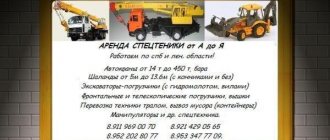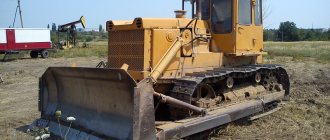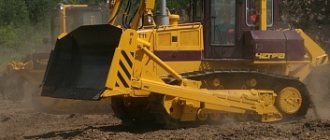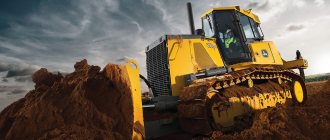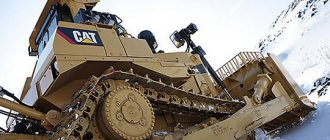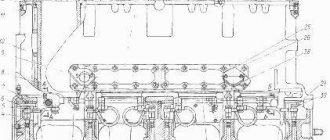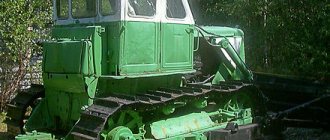Choosing the right bulldozer!
Rental of special equipment /Useful information /Choosing the right bulldozer!
Nowadays, any construction, as well as other large-scale work with soil, is difficult to imagine without heavy equipment, one of the varieties of which is a bulldozer. A bulldozer is a modified tractor equipped with a blade, that is, a shovel, which is its main working tool. Bulldozers are used for such types of work as digging trenches, moving other bulk materials on a construction site, and also as a tractor.
Bulldozers can be classified according to various indicators, for example, by the method of controlling the blade, by the type of blade itself, by the weight of the machine and its power, by the type of chassis - in most cases these are crawler bulldozers, which have increased maneuverability and the ability to move more mass and volumes of soil . But there are also wheeled tractors that, with the help of mounted bulldozer equipment, can clear the surface of light material and loosen the soil.
When choosing a bulldozer, the first thing you need to decide is the purpose of its use. Based on this, the required mass of the machine and its power are determined - in direct proportion to the volume and mass of the soil. It is also worth paying attention to the speed of movement of the bulldozer during idle and working steps - it may vary between different models and is not always directly related to power.
It is worth paying attention to the type of transmission. For example, a manual transmission is the most popular and cheapest control option. Its simplicity increases such an indicator as strength, and therefore the reliability of the structure. The hydromechanical transmission is lightweight and easy to operate, but it is more susceptible to negative environmental factors; when choosing an inexpensive bulldozer, it is better to abandon it.
The type of blade with which the bulldozer is equipped depends on the type of work, and in some cases it is possible to equip the bulldozer with various types of buckets, for example, or chain saws, etc. Dumps can be divided into three types:
- Fixed
- Turning;
- Universal;
The first is intended for the development of light types of soil, has protection at the ends in order to reduce the loss of the filled mass of material
The second is a spherical blade, which, thanks to the hinged design, allows the blade to be tilted in different directions.
The third option is also equipped with a hinge mechanism and is designed both for careful removal of the soil layer, thanks to the lower straight serrated edge, and for transporting the soil using the upper spherical part. The use of bulldozers equipped with this type of blade is quite much wider.
Additional equipment for bulldozers allows you to expand the scope of application of these machines. As an example, a bulldozer-ripper equipped with a bucket with a different number, size and arrangement of teeth depending on the type of soil.
The AvtoSpetsTrans company has a wide range of bulldozers for rent. Our specialists will help you choose a car based on your individual situation. You are guaranteed to be satisfied and not overpay.
You can rent a bulldozer in the city of St. Petersburg by phone.
Job Description for Bulldozer Driver
368 22903
We bring to your attention a typical example of a job description for a bulldozer driver, sample 2020. A person with education, special training and work experience can be appointed to this position. Don’t forget, each bulldozer operator’s instructions are handed out against a signature.
The hr-portal website provides typical information about the knowledge that a bulldozer operator must have. About duties, rights and responsibilities.
This material is included in the huge library of job descriptions on our website, which is updated daily.
General provisions
1. The bulldozer driver belongs to the category of workers.
2. A person with secondary vocational education or primary vocational education and special training is accepted for the position of Bulldozer Operator, without presenting any work experience requirements.
3. The bulldozer driver is hired and dismissed from the position of the _______ organization upon the recommendation of ________. (director, manager) (position)
4. The bulldozer operator must know:
a) special (professional) knowledge for the position:
— design, operating principle and technical characteristics of tractors and attachments.
— methods of installation and dismantling of attachments.
— causes of malfunctions and ways to eliminate them.
— rules for the development and movement of soils of various categories at different development depths.
- rules for layer-by-layer filling of embankments - rules for developing excavations, filling embankments and planning areas according to given profiles and elevations.
— instructions for use, operation, storage of devices, tools, measuring instruments and other technical means used in their work.
— sketches and drawings directly used in the process of work.
— requirements for the quality of work in related construction processes;
b) general knowledge of an employee of the organization:
— rules on labor protection, industrial sanitation and fire safety;
— rules for using personal protective equipment;
— requirements for the quality of work (services) performed and for the rational organization of labor in the workplace;
— range and labeling of materials used, consumption rates of fuels and lubricants;
— rules for moving and storing goods;
— types of defects and ways to prevent and eliminate them;
— production alarm.
5. In his activities, the bulldozer driver is guided by:
- legislation of the Russian Federation,
— Charter (regulations) of the organization,
- orders and instructions of the _______ organization (general director, director, manager)
- this job description,
— Internal labor regulations of the organization.
6. The bulldozer operator reports directly to _________ (a worker with higher qualifications, the head of production (site, workshop) and the director of the organization)
7. During the absence of the Bulldozer Driver (business trip, vacation, illness, etc.), his duties are performed by a person appointed by ________ organization (manager position) upon the recommendation of ________ (position) in the prescribed manner, who acquires the corresponding rights, duties and is responsible for the performance duties assigned to him.
Job responsibilities of a bulldozer driver
The job responsibilities of a bulldozer driver are:
a) Special (professional) job responsibilities:
— Performing work with bulldozers with engines of various power.
— Development, movement of soils and planning of areas during the construction of excavations, embankments, reserves, cavaliers and banquets during the construction of roads and railways, irrigation and shipping canals, dams, protective earthen dams, pits for buildings and structures, supports for power lines and contact networks and other similar structures.
— Carrying out emergency restoration work on railway transport.
— Performing work underwater with a bulldozer.
b) General job responsibilities of an employee of the organization:
— Compliance with the internal labor regulations and other local regulations of the organization, internal rules and regulations of labor protection, safety precautions, industrial sanitation and fire protection.
— Fulfillment, within the framework of the employment contract, of the orders of the employees to whom it was repaired in accordance with these instructions.
— Carrying out work on acceptance and delivery of shifts, cleaning and washing, disinfection of serviced equipment and communications, cleaning the workplace, fixtures, tools, as well as maintaining them in proper condition.
— Maintaining established technical documentation.
Bulldozer driver's rights
The bulldozer driver has the right:
1. Submit proposals for management’s consideration:
— to improve work related to the responsibilities provided for in this instruction,
— on bringing to material and disciplinary liability workers who violated production and labor discipline.
2. Request from structural divisions and employees of the organization the information necessary for him to perform his job duties.
3. Get acquainted with the documents defining his rights and responsibilities for his position, criteria for assessing the quality of performance of official duties.
4. Get acquainted with the draft decisions of the organization’s management relating to its activities.
5. Require the management of the organization to provide assistance, including ensuring organizational and technical conditions and execution of the established documents necessary for the performance of official duties.
6. Other rights established by current labor legislation.
Responsibility of the bulldozer operator
The bulldozer operator is responsible in the following cases:
1. For improper performance or failure to fulfill one’s job duties provided for in this job description - within the limits established by the labor legislation of the Russian Federation.
2. For offenses committed in the course of their activities - within the limits established by the current administrative, criminal and civil legislation of the Russian Federation.
3. For causing material damage to the organization - within the limits established by the current labor and civil legislation of the Russian Federation.
Job description for a bulldozer driver - sample 2020. Job responsibilities of a bulldozer driver, rights of a bulldozer driver, responsibility of a bulldozer driver.
Bulldozer: wheeled and tracked
Bulldozer equipment with wheeled and tracked propulsion ranks third in quantity among the special equipment produced after lifting equipment and special-purpose vehicles.
Bulldozer: wheeled or tracked
Comparing special equipment at the level of the type of propulsion or transmission and without taking into account the purpose is not entirely correct. But a comparison of the characteristics of bulldozers with wheeled and tracked propulsion with equal engine power and, partly, weight will explain the applicability of this equipment in terms of productivity and economical operating costs. Let's take bulldozers as an example:
- wheeled T-150 KD
- tracked T-150 D.
Let's leave the aesthetic and ergonomic characteristics of the machines outside the brackets.
Comparison of propulsion types
A wheel and a caterpillar are fundamentally different types of propulsion elements. The endless belt and the wheel circumference have much in common, but there are many more differences.
Ground pressure and flotation
The specific pressure of bulldozer tracks weighing 8 tons on the ground is about 46 kPa (~ 5 kgf/sq. cm), which is 3...4 times less than that of the wheeled version, depending on the type of tire and the pressure in it. But in the case of movement on a hard surface or frozen ground, the entire load falls on the “rowing” protrusions of the caterpillar tracks, which leads to the destruction of the coating at the points of contact of the track with the surface, which makes it necessary to transport the bulldozer to the work site on a trailer. The cross-country ability and pushing (pulling) force on medium-difficult soils without moisture are approximately the same for both propulsors.
Operational features of propulsors
Structurally, the caterpillar is a multi-link, highly loaded chain of tracks connected by hinges. It is the load on the track fingers that is the limiting factor in the speed of movement. So, if we take a speed of 5 km/h as a unit, then at a speed of 9 km/h the load increases by 1.5 times, and at a speed of 15 km/h (max) - three times. Wear of bulldozer track elements depends on the track tension, the condition of the damping mechanisms of the road wheels and operating conditions. Track repairs involve significant labor costs.
The wheeled bulldozer allows operating speeds on light soils or snow or unloaded movement of up to 30 km/h without serious tire wear. Tire care involves monitoring tire pressure.
The service life of tracks with an open joint is 900... 1200 hours, which is not comparable to the mileage of tires, which depends on the tire pressure, the complexity of the soil and the qualifications of the bulldozer operator.
Controllability and maneuverability
Maneuvering a crawler bulldozer is carried out using friction clutches, which transmit force from the engine to each caterpillar. The turning radius depends on the speed ratio of each of the drive wheels of the track.
To reduce the turning radius, the wheeled bulldozer has a composite frame with an axle between its two parts. The articulated frame design, in combination with the 4x4 wheel arrangement, provides a turning radius of up to 6.5 m (for comparison, the GAZ-31105 with a wheelbase of 2.8 x 1.4 m is 5.8 m).
Conclusion
- equipment must be used for its intended purpose:
- The crawler bulldozer is designed to work on difficult soils and waterlogged soils. The damping elements of the rollers ensure a constant contact patch between the tracks and the ground, which gives it high maneuverability and stable working force.
- A wheeled dozer works well in light to medium dry soils or snow cover. A wheeled bulldozer has a high travel speed and sufficient maneuverability, which allows the use of various attachments on the front and rear attachment points.
